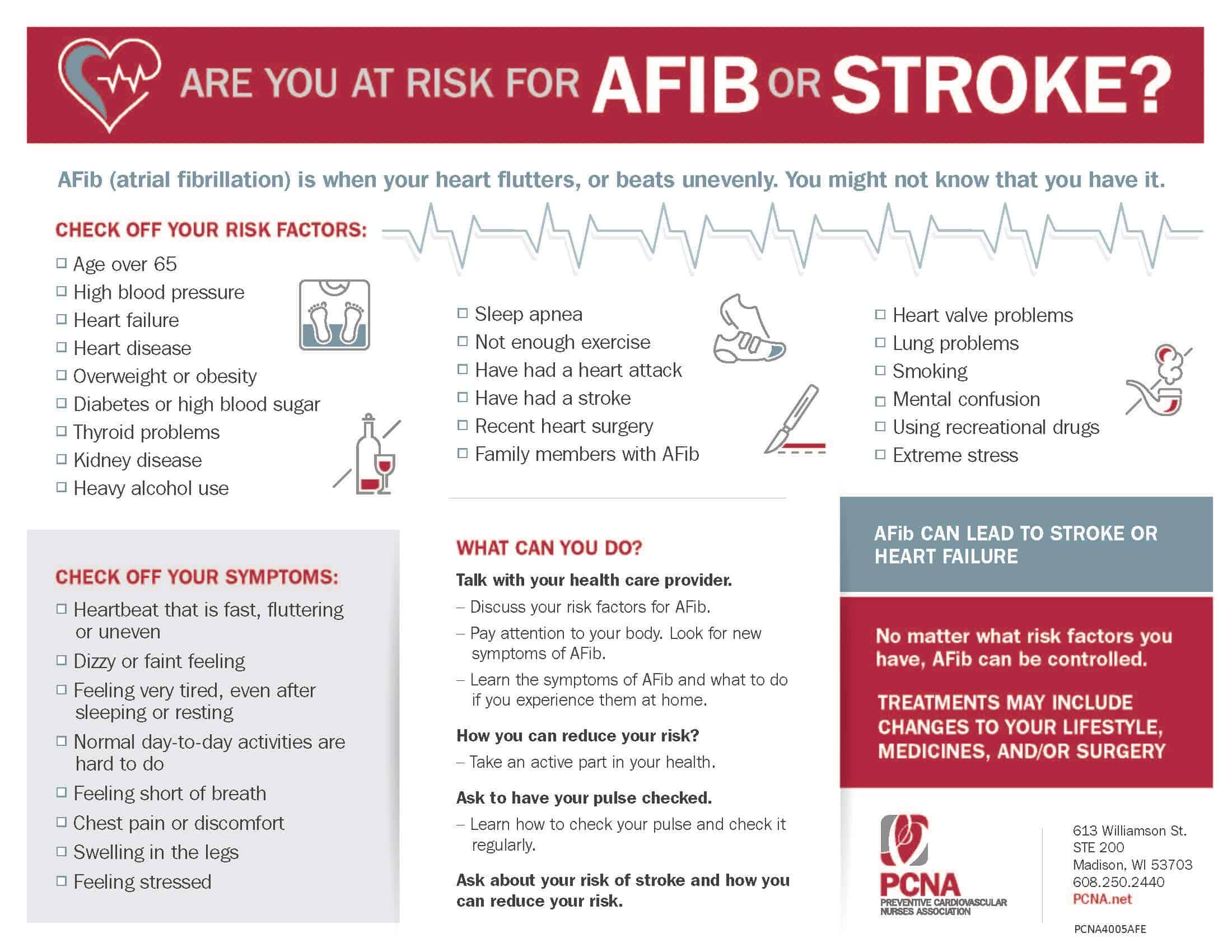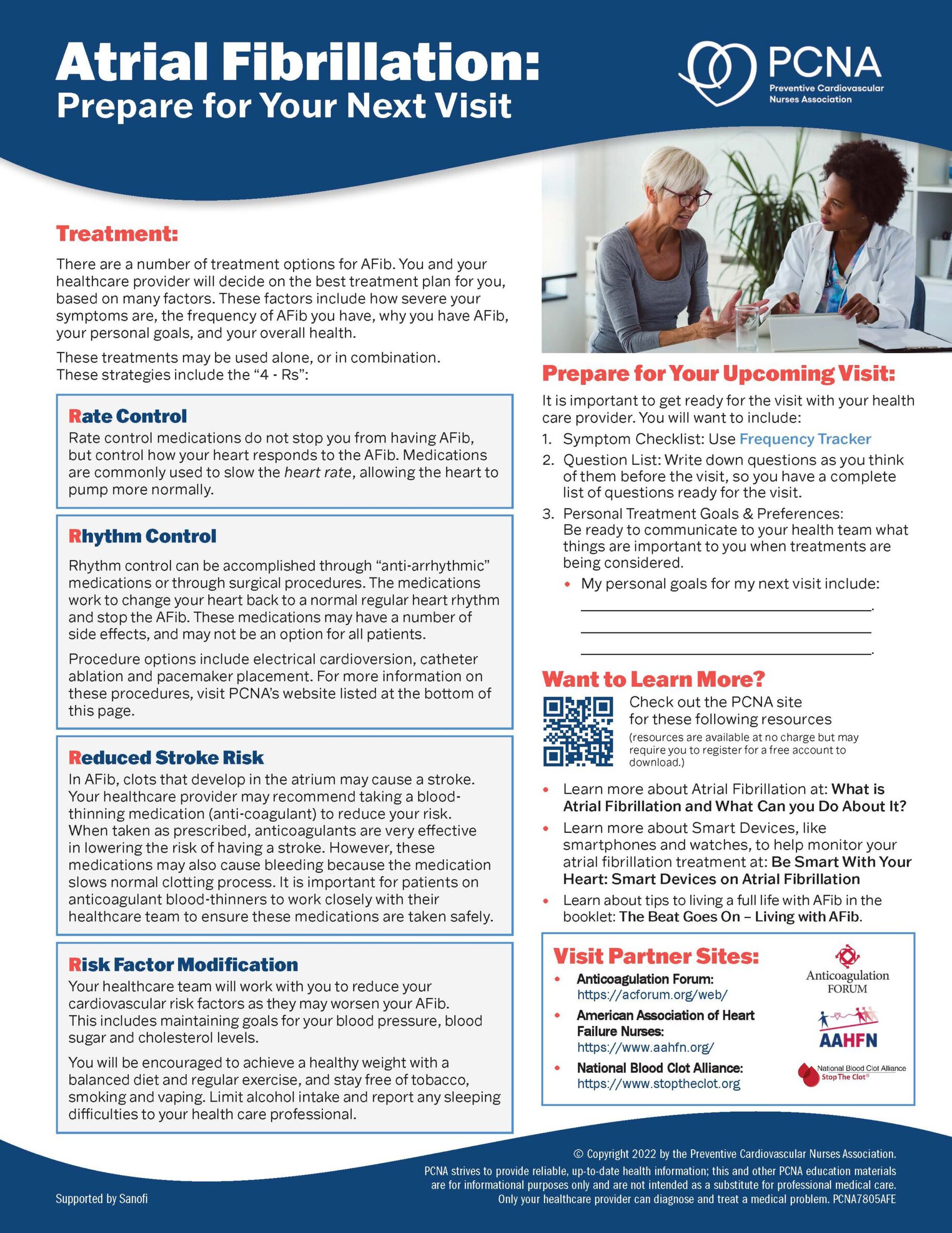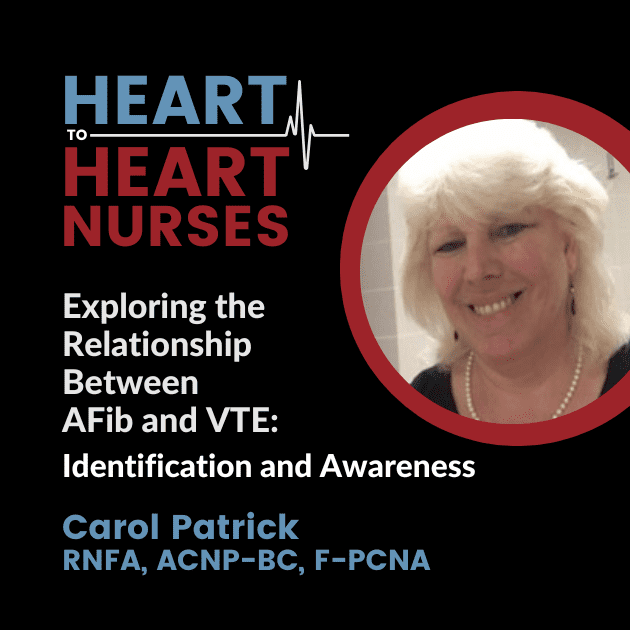Atrial Fibrillation (AFib) and Venous Thromboembolism (VTE) have a risky bidirectional relationship. Hear from Carol Patrick, RNFA, ACNP-BC, FPCNA, as she explores this relationship and the different management and prevention techniques. Also learn about how cancer can increase a patient’s risk for AFib and VTE.
Thank you to the Bristol-Myers Squibb – Pfizer Alliance for supporting this episode.
Episode Resources
- PCNA AFib provider tools
- PCNA VTE patient tools and handouts
- Atherosclerosis Risk in Community (ARIC) Study
- Pulmonary Embolism and Atrial Fibrillation: Two Sides of the Same Coin? A Systematic Review
- Differential Presentations of Arterial Thromboembolic Events Between Venous Thromboembolism and Atrial Fibrillation Patients
- American College of Cardiology Atrial Fibrillation: Guideline For the Management of Patient
- American College of Chest Physicians (CHEST)
- Anticoagulation FORUM, DOAC Playbook PDF
- National Blood Clot Alliance
- National Heart, Lung, and Blood Institute (NHLBI)
- World Thrombosis Day (WTD)
- Atrial fibrillation and cancer – An unexplored field in cardiovascular oncology
Welcome to Heart to Heart Nurses, brought to you by the Preventive Cardiovascular Nurses Association. PCNA’s mission is to promote nurses as leaders in cardiovascular disease prevention and management.
Geralyn Warfield (host): Welcome to our audience to this particular episode of Heart to Heart Nurses, where we are going to be speaking about atrial fibrillation as part of a series of three episodes on this important topic.
Our previous episode in this set of three looked at the relationship of AFib and heart failure, and today we’re going to be exploring a different relationship that between AFib and Venus Thromboembolism, which is otherwise known as VTE. As you might expect, audience, we’re going to have a lot of letters today, so we encourage you to jot things down if you’ve got questions, but we are in the capable hands of Carol Patrick today.
Carol, could you introduce yourself?
Carol Patrick (guest): Oh, I’d be glad to. Geralyn. Thank you so very much. [00:01:00] My name is Carol Patrick. I’m an acute care nurse practitioner from Long Island, New York. I’ve been a cardio-centric cardiology interventional nurse practitioner for most of my career, 38 years. And thrombosis is my focus.
So, between bringing atrial fibrillation and venous thromboembolic disease together, it would be my pleasure to talk about and explore what are the relationships that we see amongst these pathologies, and where are we in moving forward with medical management and strategies to identify and manage VTE and atrial fibrillation.
Geralyn Warfield (host): Well, Carol, you have set the stage so well for us, and I, I expect our audience can tell that we are already marching forward in our great topic today, and we’re so excited that you’re here today. I’d like to thank you for taking time to be with our audience today. So, let’s start off today talking about what the bidirectional relationships that exist between atrial fibrillation and VTE.
Carol Patrick (guest): I’d be glad to. So, when we talk about atrial fibrillation, as we know, we’re talking about that undulating, irregular chaotic rhythm of the upper chambers of the atria, where again, the blood flowing through it can become very sluggish and can go much slower.
Whereas VTE, collectively is a term of venous thromboembolic disease really pulling in pulmonary emboli, those clots that travel to the lung and DVT, deep vein thrombosis. So, both of those terms together come together to be known as a VTE. So, what we’ve seen and are exploring today is a bidirectional relationship, meaning which came first, what causes what, and what is going on in terms of patients that develop a VTE i.e., reverse or develop atrial fibrillation. What is the propensity for going forward into the other type of phenomenon? [00:03:00] So when we look and explore these two phenomenon and disease states, what we see is really that VTE and atrial fibrillation share some very common risk factors.
Patient populations, especially the elderly as we age, the propensity for both of these types of phenomena can occur. The obese, as we know, impacting their mobility and their ability to mobilize and exercise and so forth. And then there’s a lot of procoagulant states and anti-inflammatory states that do have a propensity or relationship between atrial fibrillation and venous thromboembolic disease.
So, let’s take a look at the pathophysiology of them both causing clots, arterial clots. So, when we look to atrial fibrillation, the phenomenon of atrial fibrillation has been really associated with a [00:04:00] prothrombotic state. It really looks at Virchow’s triad, for thrombogenesis, how clots are formed. Abnormal blood flow is your stasis in the atria, the vessel wall abnormalities, and the abnormal blood constituents such as the coagulation factors bringing in inflammation.
So, these Virchow triad characteristics are seen in atrial fibrillation and likewise, VTE. So, they do share in commonality these procoagulant states and pathophysiologic phenomenon. Moving forward, when we take a look at atrial fibrillation, we know that atrial fibrillation carries a five times higher incidence of thromboembolic stroke, CVA, cerebral vascular accident.
So, we do what’s called a Chads VASc two scoring system and look at the patient’s history of any cardiac disease, hypertension, [00:05:00] any sort of atherosclerotic prior, such as a carotid endarterectomy, or heart disease, and their age and the sex of them being a female comes into play. We score those patients and when we come across anybody that scores two or higher is somebody that should be on an anticoagulant for thromboembolic, non-valvular atrial fibrillation, stroke prevention.
So, although we are calling this prevention, they are on what’s considered full anticoagulation to prevent any sort of a thromboembolic stroke. So, when you have a patient presenting with atrial fibrillation, specifically new-onset atrial fibrillation, or even if it’s chronic, you need to risk assess and score them with the Chads VASc two scoring system to determine if they are being adequately anticoagulated.
And we’ll talk a little further down of the types of, of [00:06:00] choices, but in the acute phase, whether it be a Heparin infusion, low molecular weight Heparin, one milligram per kilogram Q 12-hour treatment dose. Those are appropriate while the patient is in an inpatient setting. But now, since 2010, we are so, so fortunate, so fortunate that along came the novel oral anticoagulants.
But now they’re not so novel anymore. We’ve used them, so commonly they’re now DOAC’s, direct-acting oral anticoagulants. The first one to arrive was the DTI, the oral agent called Dabigatran, and that is a little different than the Factor Xa inhibitors. The Factor Xa inhibitors that most commonly you will all come across is your Rivaroxaban or Xarelto or your Apixaban or Eliquis.
And now we have some newer ones coming down [00:07:00] that are depending on what you are in the nation, Edoxaban and Savaysa is the other name, as well as some others in the works. So, each generation, each new company that comes out with these oral anticoagulants that are direct acting on as Factor Xa inhibitors, it’s just a marvelous thing. Because prior to 2010, all we had was called the vitamin K antagonist, Coumadin, or Warfarin. And as we all know, warfarin carries with it a lot of therapeutic monitoring, dietary adjustments in terms of the green leafy vegetables in moderation and balance, and a lot of drug interactions with warfarin.
So, we’ve come a long way since that time, and we’re just thrilled to be able to offer a lot of these newer agents for our patients in these different disease states. Not to say Warfarin or Coumadin is not appropriate for [00:08:00] certain patients still, because our DOACs, we have to be aware of the creatinine clearance in the Glomerular filtration rates. So, that’s the first thing one must do when they’re assessing and determining if a patient should be on a DOAC. They need to calculate their Glomerular filtration rates. If it’s less than thirty ccs per minute, then they should not be recommended for a DOAC. So that’s off the table.
There are other types of dose reductions that can be done, and again, even in the renally impaired patient, we have seen some types of patients using the Apixaban in a reduced dosing setting. So, it’s not to say, again, you have to look at the individual case, the patient, their tolerance. But the big focus for the patient presenting with atrial fibrillation is to calculate and make sure you know what their renal function is [00:09:00] doing and watch it, and it should be checked every three to six months while they’re on a DOAC.
So going back to our patient population with AFib and or VTE, venous thromboembolic disease. We take a look at just the types of pathology of who’s at risk for a venous thromboembolic event. So again, sharing the risk factors when you look at a VTE patient, they’re immobile. They could be in the ICU. They could have a genetic coagulopathy, certain patients that are either born with that coagulopathy sometimes they have certain factor five leiden or certain genetic deficiencies in their clotting or hypercoagulable states. And then you take a look at their obesity, tobacco use, [00:10:00] oral contraception use, long-distance air travel. So, there’s a host of factors that fall into play with the patient that’s at risk for developing venous thromboembolic disease.
So how do these two cross over on each other and how do they interrelate?
So, one of the things in our journey that I wanted to share with you is what’s called the ARIC study, because that study took a look at 15,792 patients in our nation. Specifically, they were either African American or Caucasian from four of our suburb communities in Minneapolis, Minnesota; North Carolina; Jackson, Mississippi, and a lot of suburbs in Maryland.
So, they looked at these patients for two years and followed them for their hospitalizations and what was going on with them, with their risk [00:11:00] factors and development of whether it be atrial fibrillation or venous thromboembolic disease. And they really came across a lot of commonalities. Specifically, if a patient developed atrial fibrillation.
During this trial, I wanna just tell you what the name is, it’s called the Atherosclerosis Risk in Community Study. So that’s what ARIC stands for. I place that in my reference list for you to look and observe and follow because it’s a very helpful study that has a huge population of patients that brought forth some very, very prominent findings in what’s going on with the patient’s development of AFib or VTE.
So, the association was bidirectional again, the incidence of AFib and VTE. The AFib had a twofold increase [00:12:00] risk of future VTE. Specifically, oftentimes within the first six months of the development of atrial fibrillation. They also saw the incidence of VTE, particularly pronounced in the first six months. Again, when one occurred after the other, so within six months, whether they developed AFib or VTE or vice versa, it was a bidirectional look.
So, they really had to take another deep dive into what is the incidence and how are we preventing or observing these kinds of patients. So, in conclusion, what they really came across is that AFib has a twofold greater risk of being diagnosed with an incident VTE. Again, predominantly within the first six months and the subsequent, six months after, they are still at risk again, having atrial fibrillation.
[00:13:00] So they really, you know, kind of took a nicer approach to, what is it? You know, how can we prevent future VTE occurrences. And essentially if the patient is Chads VASc scored and they score two or greater, they are already protected per se, they’re being treated with a DOAC or warfarin for the atrial fibrillation so it crosses over onto the VTE side. So, I think, that’s the key is recognizing the occurrence of atrial fibrillation.
And I want to just note those patients that have Paroxysmal AFib, where the AFib comes and goes, have just as much a risk of stroke thromboembolic stroke as those that have chronic or persistent AFib. Very important factor to bring forth in the atrial fibrillation population. As an electrophysiology nurse practitioner, we could be checking a device. The patient could have had a ventricular [00:14:00] tachycardia, had a defibrillator placed, and woo, low and behold, we see Paroxysmal AFib, bouts of AFib. Whether it’s eight minutes or eight hours or 80 days, the propensity is still the same. Meaning they still need to be risk scored and assessed and managed with a DOAC or warfarin.
So, it’s very important to understand that concept that Paroxysmal AFib is just as high a risk of thromboembolic stroke as the patient that’s got persistent AFib. And these AFib patients are five times higher at risk of thromboembolic stroke if untreated or not on their DOAC, than the general population.
So, these startling statistics are important as providers to recognize and work forward in terms of how we are going to manage these [00:15:00] patients. So atrial fibrillation, as we know, has many faces, many ways to manage, but always look at non-valvular atrial fibrillation, stroke prevention. Score your patients, Chads VASc two is the scoring system. And in addition, you would do a HAS-BLED score, bleeding score. You want to make sure that that delicate balance is addressed and that you manage the patient accordingly. So, bleeding, clotting, making sure the patient understands that they’re fully anticoagulated on a DOAC. That you know you remove any rugs or throw rugs that they don’t trip. They should wear a helmet if they decide to do water sports or skiing. They can do these things, but they have to manage that they’re not going to hit their head.
Geralyn Warfield (host): We’ve been talking with Carol Patrick about the delicate relationships between atrial fibrillation and venous thromboembolic diseases, and [00:16:00] we’re going to take a quick break and we will be right back.
Geralyn Warfield (host): So, Carol, previously in this episode you were discussing the impacts of diseases such as hypertension, diabetes, and other factors that can impact an individual’s risk for AFib or a VTE, or of both, as we’ve just discussed. But I’m wondering if you could talk very specifically about another disease, which has an impact here and that is cancer and how that affects an individual’s risk. Could you address that for us, please?
Carol Patrick (guest): I’d be glad to. Geralyn. Thank you so much for bringing up that third dimension that is so important in our care of our patients because as we know, moving forward into the future, there’s no one patient with just one phenomenon. We have a comorbid population of overlapping processes, risk factors, and ways to manage so, thank you for bringing forth the cancer patient.
So, cancer is something to be [00:17:00] aware of in terms of both VTE and atrial fibrillation. Mostly looking at their hypercoagulable state and the fact that they have a higher concentration in activity of prothrombotic clotting factors. So, there are a lot of overlapping types of pathophysiologies that do come into play when we look at VTE, AFib and the cancer patient.
So, the patient who has active cancer, when I say active, I’m referring to receiving either chemotherapy, radiation therapy, they’re actually actively going undergoing treatment. That piece brings into another grid of checkoffs or checklist to be addressed for the nursing provider caring for this patient.
The first thing obviously is looking at what type of [00:18:00] chemotherapeutic agents are they receiving because there’s drug interactions that can occur with the medications in managing the anticoagulants that we might want for the patient. So, we really have to take a look at their chemotherapeutic profile, we need to look at obviously their blood work and their CBC, their creatinine clearance, and their Glomerular filtration rate comes into big play for these patients. And as well as we really have to take a look at just what is their functional abilities. Are they mobilizing? Are they up and about? Are they still working? Are they in bed most of the day? Are they immobile? Are they too sick to do that kind of mobility?
And that really puts us into the VTE high risk. Cancer patients have five times greater than the normal population of getting a VTE or pulmonary emboli. 4 to 20% of cancer patients will [00:19:00] experience a VTE at some stage in their cancer. Annually, 0.5% of cancer patients will have some sort of thrombotic problem compared to 0.1% of the patients on the general population.
Inversely is an important concept to understand. Often, a patient presents with a deep vein thrombosis, a DVT from unknown or asymptomatic cancers. So, in my practice I’ve seen very often a patient that presents, could be a 55-year-old male, has no symptoms, presents severe pain and edema in the left lower extremity. They have their ultrasound if it’s positive for DVT, why? Why are they clotting? So, if you have an unprovoked type of an occurrence, get them checked, [00:20:00] refer them to a hematologist oncologist to look further and do a coagulable profile as well as a hematology consult because it could very well be, that’s the first sign that the patient has some sort of a malignancy going on. So, you might have saved from a very long-term problem or acute demise because of the fact that you looked further as to why was there an unprovoked DVT. So, cancer does play very well into the hands of venous thromboembolic disease. Again, due to the nature of their pro-thrombotic state and the type of patients that we see.
Atrial fibrillation, on the other hand, has a little more unknowns in terms of how it relates to cancer, but they do feel it interacts from [00:21:00] several types of contributions from the systemic inflammation that cancer causes into contributing to atrial remodeling, so the cancer can bring on that atrial remodeling and start the whole cycle of atrial fibrillation going on in a patient that prior to cancer development did not have atrial fibrillation. So, they do have a higher risk of AFib development in the cancer patient population.
Geralyn Warfield (host): So, as we are thinking about those patients with cancer, we have already described a little bit earlier and you did a fabulous job of kind of walking through the earlier methods that we had to treat these patients or to prevent further issues. We talked about the NOAX, now the DOAX. What kind of special considerations would you have as a practitioner in dealing with a patient with cancer and then trying to address [00:22:00] prophylactically the AFib and VTE risks? Are there any special pharmacotherapy considerations that we would have?
Carol Patrick (guest): Yes, absolutely. So again, understanding the difference between prophylaxis means prevention, they do not have the active clot at this time, whether it be atrial fibrillation or VTE, or treatment. That’s treatment of a known thromboembolic event such as a thromboembolic stroke or having a DVT or a pulmonary emboli, so that would be the treatment piece of things. So, for the patient who’s got atrial fibrillation, again, what’s key is to risk score them with the Chads VASc two score and as very important for the HAS-BLED score for the patient with cancer to make sure their bleeding risk is adequate so that there’s no issues with [00:23:00] that delicate balance. And you have to look at those things, and again, renal function. So, they need a profile of looking at their creatinine clearance, the Glomerular filtration rate, and then the determination of can they take PO? Are they awake enough to take something PO or do they fare better with a subcutaneous injection?
So, a low molecular weight Heparin, or a Heparinoid product is okay and actually has fared very well in the cancer population. So, there’s the Enoxaparin trials, there’s certain trials that have really fared that Enoxaparin, a low molecular heparin subcutaneously, does fare very well for Thromboprophylaxis in the cancer patient, and even for ongoing treatment for the dosing.
So, the patient with active malignancy, again, can have a DOAC, could be a Apixaban, Edoxaban, or [00:24:00] Rivaroxaban, in that order, but without any gastric or gastroesophageal lesions. If they do have an active cancer in the gastric area, then Enoxaparin is the preferred medication of choice, because it’ll be subcutaneous, and they do not have to go through the oral route.
So, my advisement is to risk score and assess your patients. Take a look at the delicate balance, the bleeding, the clotting, look at all the risk factors for VTE as well as the atrial fibrillation patient, and where does that patient stand or sit within those decision-making tools. And obviously you need to have a conversation with the patient, the family, because are the acquisition costs doable for that patient because you can prescribe it and maybe they cannot afford it. So, there are coupons and prescription [00:25:00] plans for these patients, but you do need to assist them in acquiring the medication and that does come into play.
In terms of a low molecular weight Heparin for the cancer patient, which is very adequate and ideal. Who’s going to administer it? Does the patient have the ability to give their own injection, or do they have a support system? Do they have a caregiver that can inject in the subcutaneous tissue? Is that feasible for the patient to endure? Some patients, I’ve had 28-year-olds with tattoos all up and down their arms, and I try and give them a dose of Enoxaparin and they pass out. So, it all depends on how their approach to this medication is and what they feel is the right management strategy for them.
And lastly, but most importantly, the whole team has to come into the play. Your dietician, their ability to take PO. Obviously, they’re creatinine clearance, the renal [00:26:00] function, the physician on the team, the oncologist, as well as the family and the support system. And we talked about acquisition costs.
So, all of those things, in addition to the scoring tools of the Chads VASc two for the AFib patient. And there are scoring for VTE as well, we have the improve and the Caprini scores, which we use in the inpatient side of the hospital, but the risk factors are the same. And obviously there’s not that much risk assessment that you need to do for VTE for the cancer patient because they’re five times higher at risk, they’re all at risk for developing VTE. So, it’s a no-brainer to look at what strategies we can employ from a medication standpoint, which anticoagulant works for them. And again, we reviewed the risks and the scores and which types of pathways to go down depending on all their needs.
Geralyn Warfield (host): It has been a delight to speak to Carol Patrick today, who has shared her expertise [00:27:00] about atrial fibrillation, about VTE and special considerations that we have when we have patients that are dealing with cancer, either active or in remission. Just some special things that we need to keep in mind for them.
We are also very grateful to the Bristol Myer Squibb – Pfizer Alliance for their unrestricted grant for this particular podcast episode. This is your host, Gerald Warfield, and we will see you next time.
Thank you for listening to Heart to Heart Nurses. We invite you to visit pcna.net for clinical resources, continuing education, and much more.
Topics
- Atrial Fibrillation
- Venous Thromboembolism (VTE)
Published on
October 18, 2022
Listen on:

RNFA, MS, CCRN, NEA-BC, ACNP-BC
Related Resources









